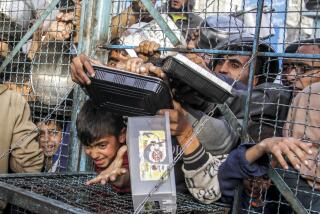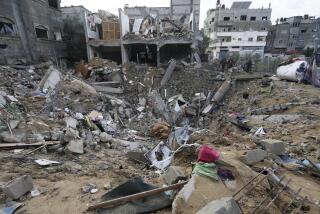Struggling Afghan Relief Crews Gird for War
- Share via
PESHAWAR, Pakistan — Working almost blind, with only frightened Afghan staff to rely on, foreign relief agencies struggling to feed the people of Afghanistan are also girding for a catastrophe they can feel coming.
Rumblings of a looming war with U.S.-led forces have set off a human tide of at least 1 million Afghan refugees heading for different borders, and despite growing pressure from nongovernmental groups, the United Nations refuses to send in more food supplies.
There is no point in doing that, because the trucks needed to deliver relief along the war-ruined roads of Afghanistan are now full of people fleeing their homes, said Khaled Mansour, a spokesman for the U.N. World Food Program here.
The agency has about 14,000 tons of relief food stockpiled in Afghanistan, but that has to feed at least 3 million people and could run out as early as two weeks from now--if there is anyone left to distribute the last sacks of wheat.
The U.S. is sending 65,000 tons of wheat for Afghan relief that it promised before the Sept. 11 terrorist attacks on New York and the Pentagon, and it has pledged 100,000 additional tons, Mansour said.
With more donors promising help by the day, the problem isn’t finding food but getting it to Afghans fleeing into the countryside and neighboring countries, Mansour said.
“Under full, normal operations, we have about 300 local staff inside Afghanistan,” he said. “But because there are so many difficulties in communicating with our offices, I can only tell you that most of them are still working to the best of their ability under the circumstances.”
Officials from about 50 nongovernmental relief organizations tried to persuade the U.N. food agency to lift its suspension of aid to Afghanistan during a meeting Saturday in Islamabad, the capital of neighboring Pakistan.
Andrew Wilder, field director for Save the Children’s Afghan relief effort, dismissed as excuses the U.N.’s claims that it can’t send more food because many nongovernmental groups have pulled out of the country, transportation is difficult and security is likely to be a problem.
“It’s a fairly indefensible position,” Wilder said. “With winter just ahead, maintaining shipments is critical.”
Mansour said the U.N. is working on several contingency plans to overcome a shortage of trucks and access routes, including moving sacks of wheat by donkey, a method it has used before.
Aid officials are worried that an American-led attack would make the already difficult job of food distribution impossible inside Afghanistan, but fear of war isn’t what’s forcing many Afghans to flee now, Wilder argued.
“Everyone is focusing on population movement because of fighting, but the real cause is food,” he said.
The last foreign aid workers in Afghanistan, including two U.S. women, are locked in a detention center in Kabul, the capital, on charges of preaching Christianity. So hundreds of Afghans working for various relief agencies are trying to keep feeding the hungry on their own as they weigh the risks to themselves and their families.
The U.N. says the fundamentalist Islamic Taliban regime hasn’t threatened the food agency’s local staff but did cut off communication links with the Kabul office. If a U.S.-led force attacks, Afghan relief workers will have to fear for their own lives as they fight to save others’.
“In the current climate, it’s getting more and more difficult for them to do that,” Rupert Colville, a spokesman for the Office of the U.N. High Commissioner for Refugees, said here Saturday.
“They’re being told: ‘It’s up to you. You can make the security judgments.’ A lot of our Afghan staff are very, very dedicated, but they are not stupid.”
The U.N. refugee agency, which was caught badly off guard at the start of the North Atlantic Treaty Organization’s airstrikes against Yugoslavia in 1999, is exploring several responses this time and has not ruled out trying to create so-called safe havens inside Afghanistan.
The U.N. is flying supplies for new refugee camps, such as plastic sheeting, into Pakistan, and the Japanese government is sending tents.
Almost 23 years of war, three years of the worst drought in living memory and the harsh Taliban rule have combined to make Afghanistan one of the poorest countries on Earth, where even basic comforts are hard to find.
About 309,000 Afghan children younger than 5 die each year, which puts Afghanistan fourth from the bottom when nations are ranked for infant mortality, UNICEF reported last year.
Ethnically riven Afghanistan was dying a slow death even before the attacks in America, and relief workers fear that a prolonged conflict with U.S.-led forces would make life much worse for about 26 million Afghans still in the country.
Afghanistan’s United Nations seat is still controlled by President Burhanuddin Rabbani, who was ousted by the Taliban in 1996. Rabbani’s Northern Alliance controls about 5% of Afghanistan and has offered to help U.S.-led forces attack Taliban troops.
If the alliance gets weapons and air support from the U.S., one of its first targets is likely to be the northern city of Mazar-i-Sharif. One of the Taliban’s strongest enemies, alliance Gen. Abdul Rashid Dostum, is already threatening to attack the city.
Dostum is an ethnic Uzbek, and his forces draw support from Tajiks and other non-Pushtun groups. On Aug. 8, 1998, he lost Mazar-i-Sharif to the Taliban, which is dominated by Pushtuns, and set off a blood bath of Balkan proportions.
Over the following weeks, the Taliban massacred an estimated 6,000 or more civilians, most of them ethnic Hazaras, according to human rights groups such as the New York-based Human Rights Watch and Amnesty International.
Ten Iranian diplomats were among those killed, which almost provoked an invasion of Iranian troops into Afghanistan.
When the Taliban tried to seize Mazar-i-Sharif in 1997, 2,000 of its fighters were taken prisoner and then executed, the Taliban has charged. A U.N. team that investigated found the bodies of hundreds of soldiers who had been thrown into wells alive, or after they were shot at close range. Many had their hands bound behind their backs.
That pales against what could happen in Mazar-i-Sharif if a U.S.-led force tries to topple the Taliban, and thousands of ethnic Hazaras appear afraid of the possibility as they flee the area.
A Western aid worker who visited Mazar-i-Sharif under Taliban rule said it felt like “a city under occupation.” Since the Pushtun fighters on patrol are far from their ethnic heartland in the south, the city “could explode at any moment,” said the aid worker, who requested anonymity to protect his agency’s work in Afghanistan.
*
Watson reported from Peshawar and Marshall from Islamabad.
More to Read
Sign up for Essential California
The most important California stories and recommendations in your inbox every morning.
You may occasionally receive promotional content from the Los Angeles Times.










